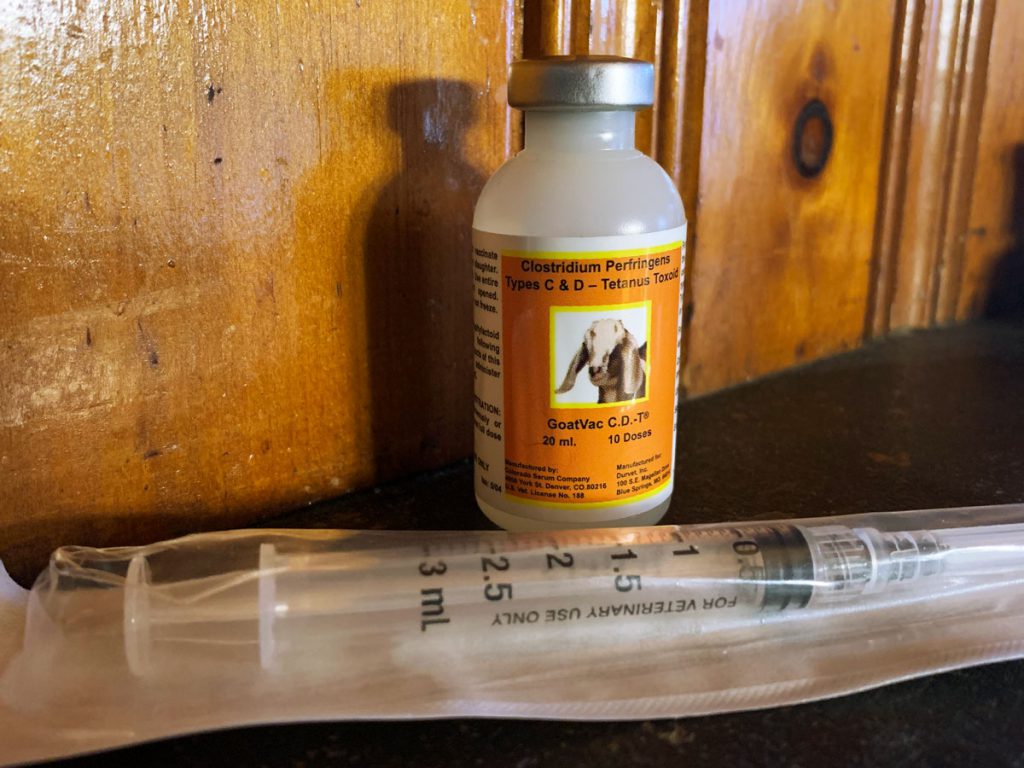All goats should receive a CD&T vaccine annually. But WHY? It’s important to know what diseases you are trying to prevent so that you understand why it is so important to vaccinate!

Enterotoxemia or “Overeating Disease”
The “CD” of CD&T refers to the bacteria Clostridium perfringens types C and D. Small amounts of this bacteria are present in the soil as well as in the gut flora of most goats and sheep. Problems occur, however, when the quantity of this bacteria increases significantly, typically due to a dramatic or rapid change in the animal’s diet. As the amount of the bacteria grows in the small and large intestines, it releases toxins that cause the animal to become sick. The intestines and other organs can be damaged. Kids are particularly susceptible, though Enterotoxemia can occur in goats of all ages.
Symptoms of Enterotoxemia include lethargy, loss of appetite, abdominal discomfort, and scours that may be bloody. Unfortunately, once signs are noticed, oftentimes it is too late to save the animal, which is why it is so important to vaccinate and prevent in the first place.
Tetanus
The “T” in CD&T refers to tetanus. Tetanus is caused by the bacteria Clostridium tetani, which lives in soil and feces. Goats are extremely susceptible to tetanus. They can be exposed to tetanus-causing bacteria through wounds, disbudding, castration, or even nicks that can occur when trimming hooves.
Treatment for tetanus in goats often fails and ends in rigid paralysis and death. Keeping your goats in clean conditions and vaccinating them is your best defense.
Where to find the CD&T Vaccine and How to Administer It
The CD&T vaccine is available over the counter at many farm supply stores locally or online. Note that CD&T vaccine must be kept cold (35°F to 45°F), so make sure to handle it carefully when transporting and store in the refrigerator at home.
The dosage for all goats, no matter what weight or age, is 2ml, injected subcutaneously.
If a goat has not been vaccinated previously, or if their vaccination status is unknown, you should always start with a 2ml dosage, then follow up 30 days later with an additional 2ml booster. After that, a 2ml booster should be given annually.
Pregnant does should be given a 2ml booster CD&T 30 days before kidding so that some immunity is passed to their kids in their colostrum. We then give kids a 2ml booster at approximately 2 weeks and 6 weeks of age to get them started.
Antitoxin or Toxoid?
There is often confusion over these terms. A toxoid is a vaccine used for prevention. An antitoxin is a treatment used when there is an immediate concern.
CD&T is a threeway vaccine (toxoid). There are also Clostridium Perfringens Types C & D Antitoxin and Tetanus Antitoxin available which are used in treatment for Enterotoxemia and Tetanus respectively.
The Tetanus Antitoxin is also used if there is an immediate need for immunity prior to disbudding or castration. The standard CD&T vaccine takes several weeks to become effective, so if you have a young goat that has not received both CD&T boosters and is about to be disbudded or castrated, you should give the Tetanus Antitoxin which gives immediate immunity for a window of 7-10 days. However, know that if you have given the antitoxin, it “cancels out” the protection of the CD&T toxoid, so you should wait 3 weeks after administering the antitoxin, then redo the CD&T series again.
As of the time of this writing (March 3, 2020), there is a shortage of Tetanus Antitoxin. This means it is even MORE important that you keep up on your CD&T vaccines!
